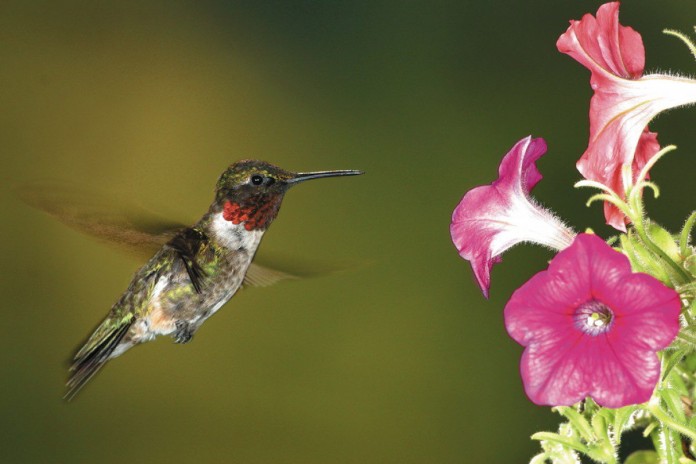One of the things I look forward to each spring is the northbound migration of ruby-throated hummingbirds. Until 1997, that meant waiting until one showed up at my feeders. But that year a website began mapping hummers as they moved north.
The first hummers usually arrive on the Gulf Coast in February. From there, their northward movement is largely determined by weather.
Michigan-based website owner, Lanny Chambers, relies on volunteers to submit reports of the first hummingbirds they see.
This year the first reports came from the Florida panhandle Feb. 21. Since then, they have been moving steadily northward. As of April 9, there were ruby-throats in Delaware, Maryland, Virginia, Kentucky, southern Illinois and Missouri.
His earliest? April 22
I usually hang one nectar feeder on the back porch April 15; the earliest record I have for a hummingbird is April 22. Look for the red-throated males to return about a week before females.
A few years ago, I detected a curious pattern in the return of the hummingbirds. When they reach southern West Virginia, they diverge. Some go east and work their way up the east coast. Others head northwest through Kentucky and Ohio.
It leaves a hummer-free gap in West Virginia and central Pennsylvania. Perhaps the cooler temperatures at higher elevations discourage movement through the mountains. By late April, however, reports usually come in from throughout West Virginia and much of Pennsylvania.
Nectar recipe
If you have not yet hung a nectar feeder, do it this week. The nectar recipe is simple — mix one part table sugar with four parts boiling water, cool and refrigerate. Do not use honey; it can harm or even kill hummers. Red dye is unnecessary because nectar feeders are red, and that’s the color that catches hummers’ attention.
If you’re offering nectar for the first time, enhance the feeder’s appeal by tying an 18-inch length of red ribbon to the feeder.
For now, one or two feeders will suffice. In the spring before nesting begins, hummer numbers at feeders can usually be counted on one hand. When young come off the nest in July, however, feeding stations attract females and young from surrounding areas.
From mid-July through August, I can usually count 10 to 20 hummingbirds (and some years many more) at my feeders.
Make my own nectar
I’m often asked if commercially prepared nectar is better than the homemade recipe made with table sugar. Boxed mixes are OK, but expensive compared to ordinary table sugar. I prefer to make my own nectar.
Boxed nectar mixes may advertise that they are fortified with vitamins and minerals, but hummingbirds satisfy their nutritional requirements from natural foods, including soft-bodied invertebrates such as spiders, aphids, and flies, which make up at least 50 percent of their diet.
Other products that might tempt you are jugs of what appears to be premixed nectar. But if you read the label, you’ll find that some of these products require added sugar. It’s just colored water that lacks the most important and expensive ingredient.
Feeding hummingbirds is like feeding seed-eating birds. It’s not necessary. Birds can find plenty of natural foods. But we offer nectar to attract hummingbirds to places where we can watch them simply because we enjoy them.
Another tip
Another tip to pull in the early arrivals is to get one or two hanging baskets for the porch near the feeders. Colorful flowers, especially red ones, may attract attention when a single feeder does not. Later in the spring a variety of potted flowering plants on the porch or deck attracts their attention as well.
And when fruit spoils, don’t throw it out. Place it in the hummingbird garden. Fruit flies and other small insects will quickly be attracted to rotten bananas, and hummers eat these soft-bodied invertebrates. Insects provide the protein and nutrients that nectar lacks.
Best way to attract them
Perhaps the best way to attract hummingbirds is to plant native, nectar-bearing flowers. Trumpet honeysuckle is a hummingbird magnet; other nectar-bearing plants to look for at native plant nurseries and garden centers include trumpetcreeper, cardinal flower, scarlet bee balm, eastern columbine and spotted jewelweed.
STAY INFORMED. SIGN UP!
Up-to-date agriculture news in your inbox!











